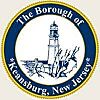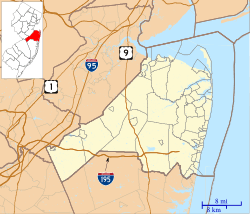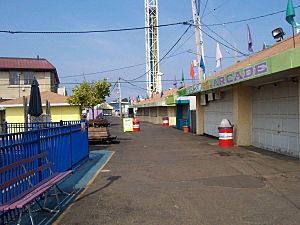Keansburg, New Jersey facts for kids
Quick facts for kids
Keansburg, New Jersey
|
||
|---|---|---|
|
Borough
|
||
|
||
| Nickname(s):
"Gem of the Bayshore"
|
||
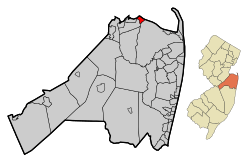
Map of Keansburg in Monmouth County. Inset: Location of Monmouth County highlighted in the State of New Jersey.
|
||
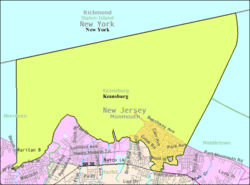
Census Bureau map of Keansburg, New Jersey
|
||
| Country | ||
| State | ||
| County | Monmouth | |
| Incorporated | April 17, 1917 | |
| Named for | John Kean | |
| Government | ||
| • Type | Faulkner Act (council–manager) | |
| • Body | Borough Council | |
| Area | ||
| • Total | 16.44 sq mi (42.57 km2) | |
| • Land | 1.07 sq mi (2.78 km2) | |
| • Water | 15.37 sq mi (39.80 km2) 93.59% | |
| Area rank | 167th of 565 in state 11th of 53 in county |
|
| Elevation | 0 ft (0 m) | |
| Population
(2020)
|
||
| • Total | 9,755 | |
| • Estimate
(2023)
|
9,648 | |
| • Rank | 250th of 565 in state 20th of 53 in county |
|
| • Density | 9,099.8/sq mi (3,513.5/km2) | |
| • Density rank | 43rd of 565 in state 3rd of 53 in county |
|
| Time zone | UTC−05:00 (Eastern (EST)) | |
| • Summer (DST) | UTC−04:00 (Eastern (EDT)) | |
| ZIP Code |
07734
|
|
| Area code(s) | 732 exchanges: 471, 495, 787 | |
| FIPS code | 3402536480 | |
| GNIS feature ID | 0885265 | |
Keansburg (/ˈkiːnzbɜːrɡ/ KEENZ-burg) is a small town, called a borough, in Monmouth County, New Jersey. In 2020, about 9,755 people lived here.
Keansburg became an official borough on March 26, 1917. It was created from parts of Middletown Township and Raritan Township (which is now Hazlet).
The town was part of a plan called the Bayshore Regional Strategic Plan. This plan aimed to make the area's economy stronger by focusing on its old downtowns, close-knit neighborhoods, history with the sea, and the beautiful Raritan Bay coastline.
Contents
History of Keansburg
The land where Keansburg is now was once home to the Lenni Lenape Native Americans.
In 1609, a ship called the Half Moon, led by Henry Hudson, is thought to have landed near Keansburg's shores. Some historians believe this happened at Sandy Hook. During this visit, a crewman named John Colman was killed by Native Americans. He is believed to be buried at a spot now called "Colman's Point."
Over time, from 1609 to the early 1700s, settlers from the Netherlands, England, and Scotland bought land from the Lenni Lenape. Farming became important in Keansburg, with crops like pears, apples, and corn.
How Keansburg Got Its Name
The area was first known as Waackaack (pronounced "Way-kay-ack"). This name came from the Lenape language and meant "Land of Plenty." It was also called Tanner's Landing for a while, named after a pier that was a main port for the area.
Later, the settlement was named Granville. This name came from the important Phillips Mill and the many grain farms. Granville had its own church, two lighthouses, and small businesses. The population was about 300 people, who mostly farmed and collected clams.
In 1877, a pastor named William W. Ramsay came to Granville. He liked the village so much that he decided to stay. He and his wife opened a general store. Ramsay worked to get a post office for the town. In 1884, the post office opened, and the town was renamed Keansburg to honor John Kean, who helped make the post office happen.
Growth and Development
More development happened with the creation of postcards showing the village. The Keansburg Steamboat Company was started in 1910. It helped bring people from New York to Keansburg who wanted to buy homes there.
Tourists from New York City would take ferries to Keansburg. They would spend weekends or summer vacations to escape the city heat. This continued until Hurricane Donna hit in 1960, damaging much of the waterfront.
In 1969, the borough spent money to protect the beaches from future storms. This plan made the beaches bigger. In the 1980s, some fires destroyed buildings on Beachway Avenue, including a dance hall and a theater.
Modern Keansburg
In 1995, the Gelhaus family bought back the Keansburg Amusement Park. This brought new excitement to the town. The amusement park was improved, and a water park called Runaway Rapids opened in 1996.
The Keansburg Waterfront Public Library opened in 2004. It was created to provide a good library for the community. In 2012, the town added a special plant that cleans water using a process called desalination. This greatly improved the town's water supply.
Geography
Keansburg covers about 16.79 square miles (43.47 square kilometers). Most of this area, about 15.71 square miles (40.70 square kilometers), is water. The land area is about 1.07 square miles (2.78 square kilometers).
Some smaller areas within Keansburg include Beacon Beach, Point Comfort, and Tiltons Corner.
Keansburg shares land borders with nearby towns in Monmouth County: Hazlet Township, Middletown Township, and Union Beach. It also has water borders with Aberdeen Township, Keyport, and Staten Island in New York City across Raritan Bay. A small part of Middletown Township is completely surrounded by Keansburg.
Population Information
| Historical population | |||
|---|---|---|---|
| Census | Pop. | %± | |
| 1920 | 1,321 | — | |
| 1930 | 2,190 | 65.8% | |
| 1940 | 2,904 | 32.6% | |
| 1950 | 5,559 | 91.4% | |
| 1960 | 6,854 | 23.3% | |
| 1970 | 9,720 | 41.8% | |
| 1980 | 10,613 | 9.2% | |
| 1990 | 11,069 | 4.3% | |
| 2000 | 10,732 | −3.0% | |
| 2010 | 10,105 | −5.8% | |
| 2020 | 9,755 | −3.5% | |
| 2023 (est.) | 9,648 | −4.5% | |
| Population sources: 1920 1920–1930 1940–2000 2000 2010 2020 |
|||
In 2010, Keansburg had 10,105 people living in 3,805 households. About 23.4% of the population was under 18 years old. The average age was 36.8 years.
Fun Places and Activities
Keansburg has many places for fun and relaxation:
- Keansburg Amusement Park
- Runaway Rapids Waterpark
- Henry Hudson Trail (a path for walking and biking)
- Raritan Bayshore Waterfront Park
- John Donohue III Park
- Keansburg Firemen's Memorial Park
- Forest Park
- St. John's Park
- World War II Memorial Park
- Friendship Park
- James Sidoti Skate Park
Emergency Services
Keansburg has its own police department, which started in 1926. Before that, the area was patrolled by a Police Marshal. The current Chief of Police is Andrew Gogan.
The town is also served by two volunteer fire companies: Keansburg Fire Company No. 1 and New Point Comfort Fire Company No. 1. These companies are made up of volunteers who help keep the community safe.
Keansburg Fire Company #1 was started in 1912. New Point Comfort Volunteer Fire Company was organized in 1912 and officially formed in 1913. Together, these two companies form the Keansburg Fire Department.
In 1998, the Keansburg EMS (Emergency Medical Services) was created. It is now a separate group that responds to many emergency calls each year.
Education
Students in Keansburg attend schools in the Keansburg School District. This district serves students from pre-kindergarten all the way through twelfth grade.
The district is one of the "SDA Districts" in New Jersey. This means the state helps pay for school building and renovation projects.
As of the 2018–19 school year, the district had about 1,642 students and 185 teachers. This means there were about 8.9 students for every teacher.
The schools in the district are:
- Keansburg Preschool (for Pre-K students)
- Joseph C. Caruso School (for grades K–4)
- Joseph R. Bolger Middle School (for grades 6–8)
- Keansburg High School (for grades 9–12)
A new Joseph C. Caruso School opened in 2016. It is a large, modern school that cost $51 million to build.
Transportation
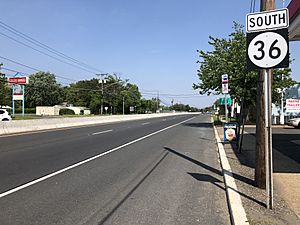
As of 2010, Keansburg had about 27.53 miles of roads. Most of these roads are maintained by the town itself.
Route 36 runs along the southern edge of Keansburg. You can also get to the Garden State Parkway from Route 36 in nearby Hazlet.
For public transportation, NJ Transit offers local bus service on the 817 route.
Notable People
Many interesting people have lived in or are connected to Keansburg:
- Eugene J. Bedell (1928–2016), a politician who served in the New Jersey General Assembly.
- Ken Croken (born 1950), a member of the Iowa House of Representatives.
- Frank H. Field (1922–2013), a chemist known for his work in chemical ionization.
- James P. Maher (1865–1946), a New York City Congressman who later became Mayor of Keansburg.
- Jason Mewes (born 1974), an actor famous for his role as Jay in movies by Kevin Smith.
- John Montefusco (born 1950), a former professional baseball player for the New York Yankees.
- Lou Taylor Pucci (born 1985), an actor.
- Horace M. Thorne (1918–1944), who received the Medal of Honor for bravery during World War II.
- Roger "Hurricane" Wilson (born 1963), an electric blues guitarist, singer, and songwriter.
See also
 In Spanish: Keansburg para niños
In Spanish: Keansburg para niños


